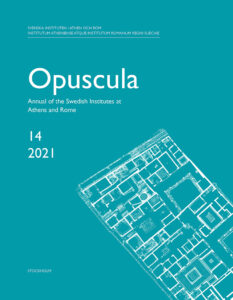 Opuscula is published by the Swedish Institutes at Athens and Rome, with the aid of a grant from the Swedish Research Council. Distributed by Eddy.se AB. View journal at ERIH PLUS. All content available with open access.
Opuscula is published by the Swedish Institutes at Athens and Rome, with the aid of a grant from the Swedish Research Council. Distributed by Eddy.se AB. View journal at ERIH PLUS. All content available with open access.
Life and death in ancient Hermione. Excavations in the necropolis
By Angeliki Kossyva (Ephorate of Antiquities of the Argolid, Greece)
Abstract
The wealth of ancient Hermione is no longer visible: continuous habitation from c. 3000 BC down to the present day has obliterated most traces. Important information on the social organization and economy of Hermione can however be drawn from the tombs that have been unearthed. A large cemetery was discovered in the early 20th century just outside the city gate, stretching along the road leading to ancient Mases and in continuous use for a period of 1,500 years. It covers an area of 1.5 km east–west along the modern Hermione–Kranidi rural road, taking in the terrain to either side to a width of 160 m and extending south to Pron Hill and north to a patch of level ground some 60 m wide. In this article we focus on cemetery finds unearthed in the area south of the present-day Gymnasium-Lykeion school of Hermione, as they typically reflect the urban organization and economic development of the ancient city. These two themes comprise some of the goals pursued in the collaborative research programme between the Ephorate of Antiquities of the Argolid and the Swedish Institute at Athens.
Download PDF - Size: 477.75 KB - Downloads: 508 (since 2023)
Bibliographical information
Angeliki Kossyva, ’Life and death in ancient Hermione. Excavations in the necropolis’, Opuscula. Annual of the Swedish Institutes at Athens and Rome (OpAthRom) 14, Stockholm 2021, 157-167. ISSN: 2000-0898. ISBN: 978-91-977799-3-7. Softcover, 478 pages. https://doi.org/10.30549/opathrom-14-09
Hermione. A Greek cityscape and its people
The section on Hermione, published in OpAthRom 14, comprises six articles:
Alcestis Papadimitriou | An ancient cityscape and its people: A study of ancient Hermione. Introductory remarks on historical sources and visible remains, archaeological research and prospects (pp. 65-76)
Henrik Gerding | The topography of Hermione—A preliminary outline (pp. 77-99)
Jesper Blid, with an appendix by Baukje van den berg | The Temple of Demeter Chthonia at Hermione (pp. 101-134)
Patrik Klingborg | The cisterns of the Bisti promontory at Hermione. With a preliminary description of the Roman aqueduct (pp. 135-155)
Angeliki Kossyva | Life and death in ancient Hermione. Excavations in the necropolis (pp. 157-167)
Jenny Wallensten | The key to Hermione? Notes on an inscribed monument (pp. 169-180)

No Comments
Comments are closed.